OMAAT commenter Andrew M. is a frequent traveler and points/miles enthusiast as well as a knowledgeable wine expert, who weighed in on the great English sparkling wine debate a couple months ago. Because wine takes on a totally different flavor and complexity at 35,000 feet as opposed to sea level, Andrew M. has offered to share his insights as to maximizing your enjoyment of wine in flight; he’s also reviewed wine on a few different first class and business class legs for comparison. Enjoy this series, and thanks, Andrew M.!
Introduction And Selecting Wine On Airplanes
Wine Review: American Business Class Beijing To Dallas
Wine Review: American First Class Dallas To Madrid
Wine Review: Cathay Pacific First Class Frankfurt To Hong Kong
Conclusion And Bottom Line
Note from Andrew M.: Apologies for the picture quality – I only had my cell phone and I didn’t want to annoy the crew too much by taking multiple shots of the wine and slowing down meal service for others.
Cathat Pacific First Class Wine
Cathay Pacific 288, FRA-HKG
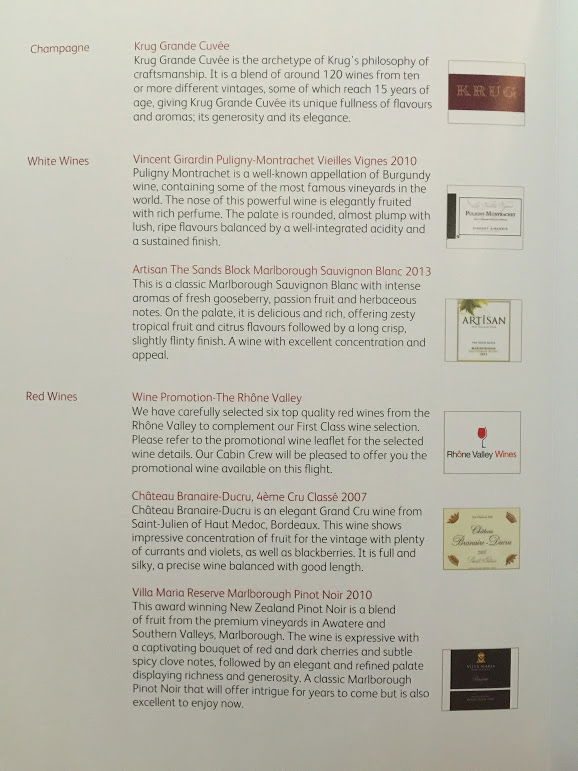
Krug Grand Cuvée
Vincent Girardin Puligny-Montrachet Vieilles Vignes 2010
Artisan The Sands Black Marlborough Sauvignon Blanc 2013
Wine Promotion – The Rhône Valley
Château Brainaire-Ducru, 4ème Cru Classé 2007
Villa Maria Reserve Marlborough Pinot Noir 2010
Wine list general commentary
A large focus on cool climate wines made me a little leery about how they’d translate in the air. The region of the Burgundy white is not known for fruit forward wines (contra the wine list descriptions). New Zealand sauvs are often quite good and fruity but while their pinots are good, they are typically not fruit forward wines.
The Bordeaux is described as “elegant” which often means subtle and complex – not a good sign; and it is from the Left Bank of Bordeaux, which, while it includes the most prestigious AOCs, is also the coolest and typically produces the most complex wines of the region.
I love Pinot – it’s probably my favorite red, but a New Zealand pinot is the definition of a cool climate red.
I like the partnership with the Rhône Valley – Rhône wines are typically spicier and more full bodied than their Northern counterparts and I previously had a great experience with a Rhône wine in American Airlines First Class.
As far as the Champagne goes, Krug is Krug and needs no introduction.
Krug Grande Cuvée
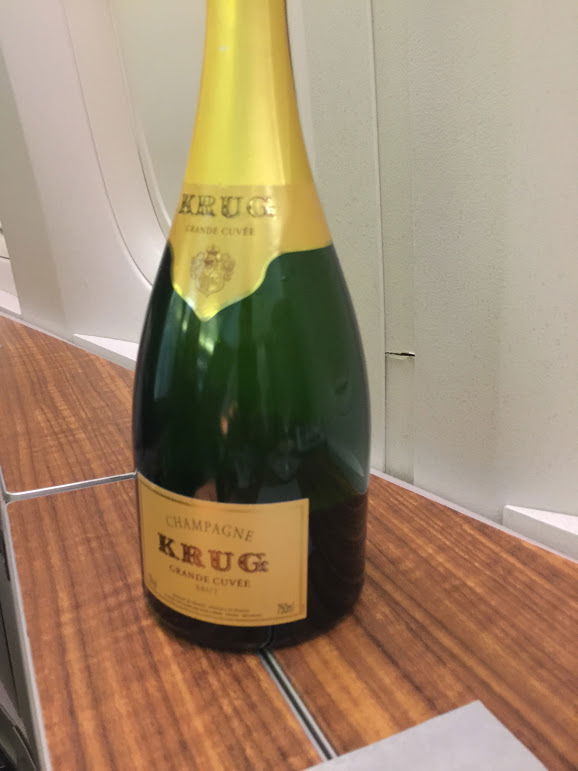
Cost: ~$150++
Tasting Notes (on the ground): A little bit of toast and spice on the nose. Green apple flavors dominant with a slight hint of berry/fig on the finish. Drinkable but a bit monoflavored.
My Rating (0-5 scale)(on the ground): 3.0
Tasting Notes (in the air): Green apple notes fade and just a modest creaminess/fig flavor remains. In some ways improves the taste.
My Rating (0-5 scale)(in the air): 3.5
Vincent Girardin Puligny-Montrachet Vieilles Vignes 2010
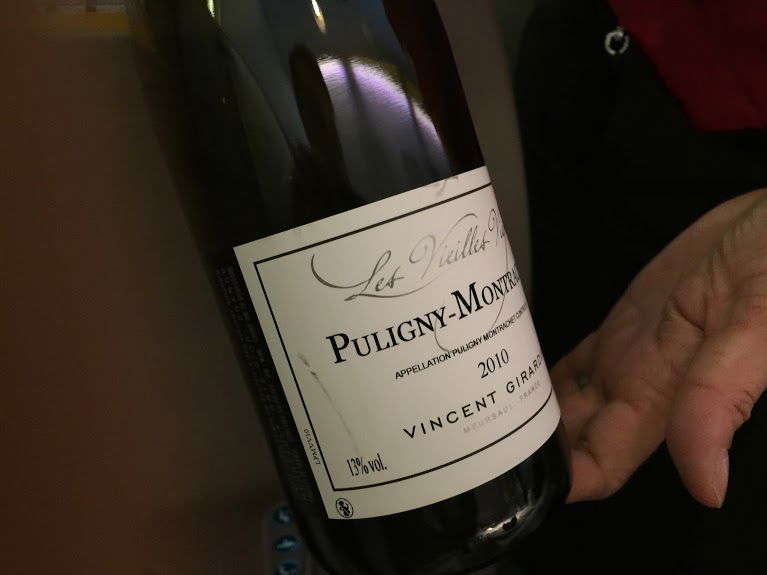
Cost: ~$58
Tasting Notes: Spicy with moderate oak presence. Modest stone fruit in the nose. Finish is modest and uninteresting.
My Rating: 2.0
Artisan The Sands Block Marlborough Sauvignon Blanc 2013
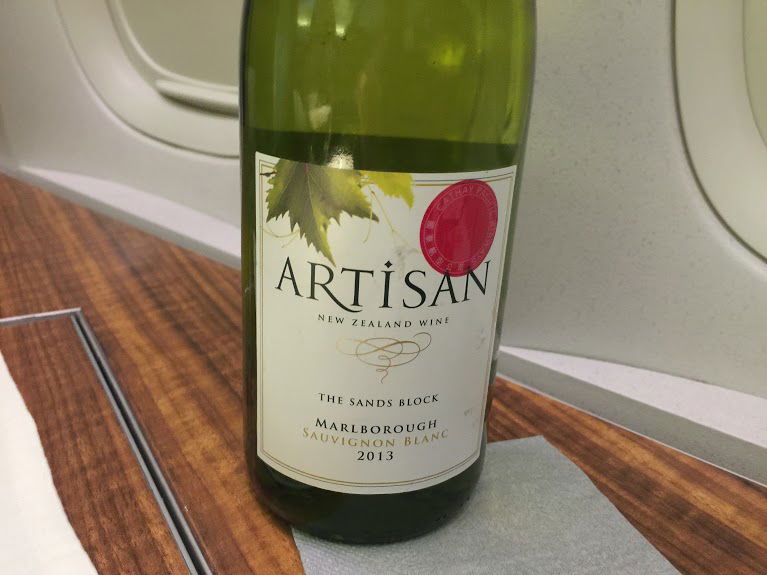
Cost: ~$19
Tasting Notes: Pear on the nose. Strong notes of gooseberry/raspberry. A pleasant and drinkable wine although not particularly complex or interesting.
My Rating: 3.0
Chateau Branaire Ducru, 4ème Cru Classé 2007
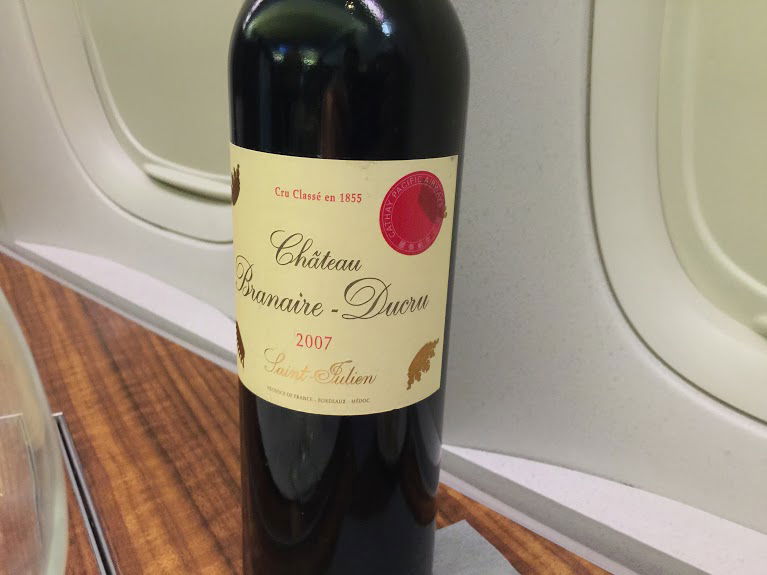
Cost: ~$55
Tasting Notes: Nose is dominated by the tannins. Very modest fruit expression. What you might expect from Trader Joe’s.
My Rating: 1.5
Villa Maria Reserve Marlborough Pinot Noir 2010
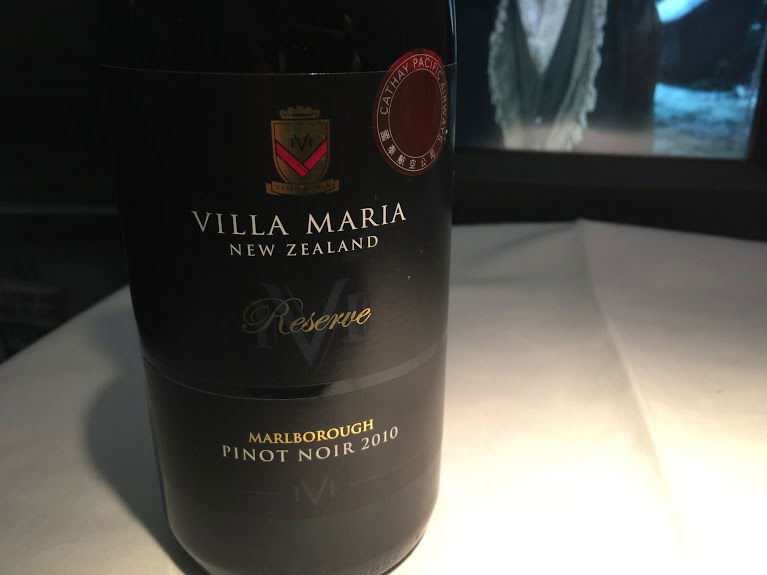
Cost: ~$28
Tasting Notes: Sweet cherries on the nose with a hint of tannins. Acidic wine with a modest cherry flavor and a bit of spiciness. Drinkable but not much interesting going on.
My Rating: 2.0
Cave de Tain Hermitage “Grand Classique” 2011
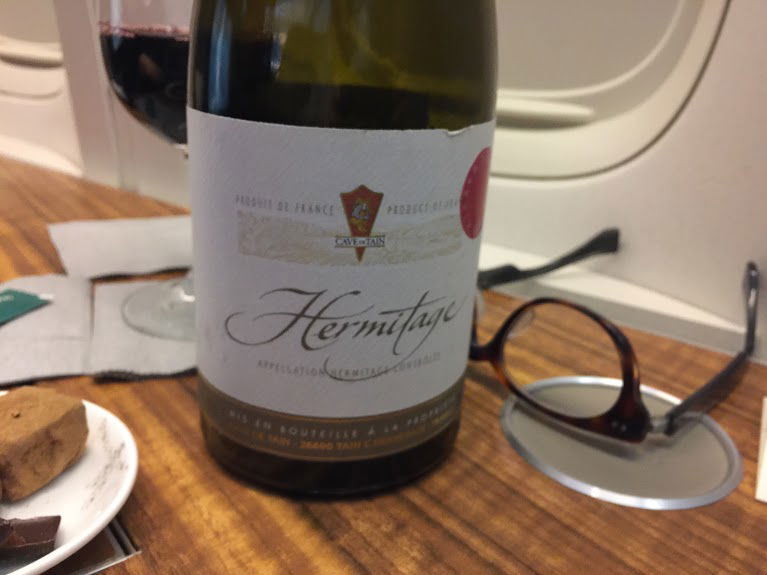
Cost: ~$35
Tasting Notes: Rich ripe fruit on the nose. Full bodied with nice tannins and acidity. Good raspberry and tobacco notes and a very pleasant cherry finish.
My Rating: 4.0
Verdict
Probably my Krug review will mean this will be my first and last post on the blog for such heresy but I actually preferred the Gosset on the ground over the Krug. Surprisingly the Krug opened better in the air as the green apple flavor became a little less dominant.
Most of the expensive French wines disappointed, no doubt because of the altitude factor. Surprisingly, from the main wine list, it was the cheapest wine onboard that I liked the most, as a good New Zealand Sauv does well on airplanes and can usually be had fairly cheaply.
In sum, a good list on paper but the list suffered from having to include “name brand” wines and cool climate wines. While Cathay’s wine list no doubt costs more than the American Airlines First Class wine list, I’d take the American Airlines First Class list hands down.
Stay tuned for further installment in Andrew M.’s series as he provides his final thoughts on in flight wine in this series.





Hi All Wine Legends,
Wine sommeliers in first class. You guys must get paid pretty well. Krug is one of the best Champagne
houses in France and Lynch Bages and Ponet Canet are some decent Vin Rouge at 35000 feet-even
with turbulence. I hope they keep having these amazing wines in long haul.
I think Airline can be serving the Best of the Best Champagne but if this happens it will definitely drop the Top position status of the Airline. I was on Cathay First from HK to JFK 9 days ago,during mid flight I asked for a glass of champagne and it was 'flat'.
I must say I have never experienced anything like this before. I told the flight attendant and it was quickly rectified but...
I think Airline can be serving the Best of the Best Champagne but if this happens it will definitely drop the Top position status of the Airline. I was on Cathay First from HK to JFK 9 days ago,during mid flight I asked for a glass of champagne and it was 'flat'.
I must say I have never experienced anything like this before. I told the flight attendant and it was quickly rectified but little touches like this certainly resulted in Cathay dropping from Best Airline in the World to 3rd Best!
Dear David,
The 'customer' doth protest too much, methinks (Hamlet-ish)
Airlines are not allowed to transfer opened bottles from one flight to another so we will assume the bottle was opened ex HKG. Some champagnes open with a bang, some a pop and some a whisper. A flat bottle could be a very old bottle which is unlikely but more likely a cork failure allowing the bubbles to escape so we must be...
Dear David,
The 'customer' doth protest too much, methinks (Hamlet-ish)
Airlines are not allowed to transfer opened bottles from one flight to another so we will assume the bottle was opened ex HKG. Some champagnes open with a bang, some a pop and some a whisper. A flat bottle could be a very old bottle which is unlikely but more likely a cork failure allowing the bubbles to escape so we must be very careful that a badly fitting cork made in rural Portugal doesn't bring an airline such as CX to its knees when put into a French wine.
If you want to find fault there might be an argument that the staff should have noticed that the bottle barely whispered when opened or that there appeared to be few bubbles in the glass but that also might be from a very clean glass so the final test might be that the staff should taste the first glass from each bottle to check the effervescence but they aren't allowed to do that.
I had a corked bottle on 1st Class EK and brought it to the attention of the, ....wait for it...on board sommellier (yeh ...right!) Can you smell the cork taint? No sir, it can't be corked as we have just opened it which isn't the right answer. Can you get me another bottle but don't take away this glass...Yes sir. The 2nd bottle was fine and I asked him to try them side by side. "I'm not allowed to do that Sir" No worries..."Can you smell the difference? Oh yes Sir. Thank you for pointing that out to me.
Cork taint is caused by a reaction in the cork with a chlorine compound that must be used on a natural product (the bark of a tree) to sterilize it. The resultant compound 2-4-6 Trichloroanisole or TCA for short will affect the good wine with a bad smell and taste from Day 1 and it can happen in as much as 10% of all wine.
I think it reasonable to expect a sommellier in a top restaurant to know this but I think it unfair to expect a CX hostie to do so. We need to educate ourselves as to what happened here and this was no ones fault so if I may be so bold, I would suggest the sequence should have gone
Excuse me but this wine appears to be flat
No problem Sir, I will open another bottle
In the unlikely event that the 2nd one is faulty then change wines and ask the hostie to take the problem to her leader.
There is another way to prevent the issue of using a piece of bark to close a bottle of wine and that would be to change to screw caps but the French refuse to do this on the grounds of tradition so the entire industry can be blamed for believing that the market that includes you and me don't want screw cap champagne. For me I would accept a screw cap than a moldy or flat bottle however infrequently it happens.
All said and done, you shouldn't blame CX here
Though I have to restrict my comments to 1st Class, I believe the CX wine list in the air is second to none in their diversity but if you need the sundrenched and fruit driven New World style then QF takes some beating. There is however one enormous difference between them and that is the wine list in their hub lounges. The Qantas lounge (Syd) is good and the CX (HKG) is embarrassing and particularly...
Though I have to restrict my comments to 1st Class, I believe the CX wine list in the air is second to none in their diversity but if you need the sundrenched and fruit driven New World style then QF takes some beating. There is however one enormous difference between them and that is the wine list in their hub lounges. The Qantas lounge (Syd) is good and the CX (HKG) is embarrassing and particularly in their new 'Champagne Bar' and I brought it to their attention. I asked why they served good wines such as Lynch Bages in the air whilst their lounge only offered supermarket wines. They denied this and said that Lynch Bages and other comparable wines were available in their HK lounge, but as passengers we had to ask for them. This BS came to light a couple of weeks later when I went into the Wing and asked. After three levels of 'Take me to your leader' someone asked me if I was MSR and when confirmed they whispered to me 'I have your wine and would I like some now?' Would you believe the bottle arrived under his coat with a scrap piece of office paper Sellotaped to it with my name on it.
The problem is that The Peninsula group get paid a per capita $ and they want their pound of flesh that doesn't include decent wines. The Champagne Bar selection is poor with nothing but the big factory fizz suppliers. There are no Grand Cru wines at all and no blanc de blancs. Same reason.
Everyone who goes through CX in HK owes it to the rest of us to ask for Lynch Bages to put The Peninsula on test to supply a wine that as a 5th growth is hardly the Dog's B's but substantially better that their other red wines which I would estimate cost them an average of US$8/bottle. A PS would be to complain about Moet & Chandon which is only suitable for cleaning the silverware. ....and no I'm not arrogant but I happen to have owned two wine companies for 25 years and who specialise in quality....I thought CX did too but maybe they or The Pen specialise in the fattest margin possible.
@Luis Hopefully was a miscater. To be clear, I don't think Gosset was the best champagne I've ever had, but I did think it was interesting.
@Dan Yeah my lesson from all of this is to be more experimental on planes and reach out and try interesting stuff.
@Dave D Agreed. Swiss and German wines have done really well for me one planes.
I took CX from ORD to HKG returning through LAX. Each way they had a Gigondas wine special on top of the regular wine list. Couldn't tell you how good the regular list was, but the Gigondases were excellent.
I had the same experience on JAL first. Wines that would be fantastic on the ground were sadly underwhelming in the air. However, they had some clever additions that played much better. A california bordeaux blend fared better than the Pauillac, and an alsatian white (rich perfumed gewurtztraminer) did much better than the premier cru burgundy white on offer. Seems like the alsatian and german whites really do well in the air, whereas champagne, burgundy...
I had the same experience on JAL first. Wines that would be fantastic on the ground were sadly underwhelming in the air. However, they had some clever additions that played much better. A california bordeaux blend fared better than the Pauillac, and an alsatian white (rich perfumed gewurtztraminer) did much better than the premier cru burgundy white on offer. Seems like the alsatian and german whites really do well in the air, whereas champagne, burgundy and bordeaux suffer tremendously. Maybe we could arrange to skip them in the air and have a bottle when we land?
I just came back from LHR-LAX on American first class and I was actually looking forward to trying the Gosset Grande Reserve that American serves on their flagship flights. Boy was I disappointed when I found out that my flight was only stocked with Nicolas Feuillate. Is this a normal thing with American where they just swap out wines from their menu (fwiw, they didn't have the 2 red wines on their menu either)?
Agreed. For all the hoopla Cathay Pacific's first class products gets, it certainly has underwhelming wines.
The Krug review may be a little rough, but I was also not blown away by it. I flying Cathay, be sure to get your champagne fix with Piper Heidsieck at The Bridge lounge.
The more I read these the more I think you need to fly Swiss for these reviews since they use a set of Swiss wines which I think taste much better in the air than on the ground.
Thrilled the CDP was good in the air and the Rhone selection was good here. Sad the pinot wasn't good.
@Andrew M.
I think you will be forever banned from participating in One Mile at a Time again after those blasphemous comments about Krug.
But, great review. I also believe that French wines in the air don't translate into good flavours and those wines that taste like piss are the ones that do.